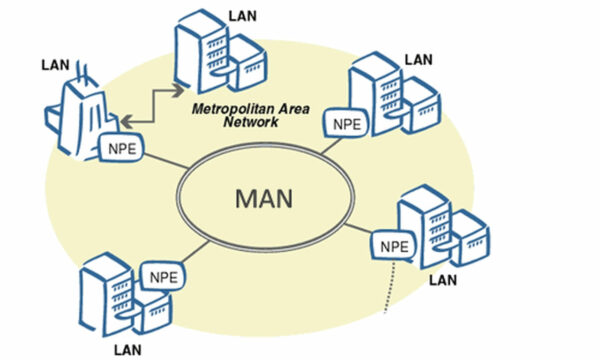✅ Last checked on
Imagine a bustling metropolis, alive with the hum of technology. The Metropolitan Area Network, or MAN, forms the digital arteries of our urban landscapes. In this article, we delve deep into the world of MANs, uncovering their importance, functioning, and impact on modern city life.
From streamlining communication to driving technological advancement, MANs play a pivotal role. Let’s embark on a journey to demystify the intricate web of Metropolitan Area Networks.
Introduction to MANs: Building Bridges in the Cityscape

In the intricate tapestry of modern urban life, connectivity is the thread that binds everything together. Metropolitan Area Networks, often referred to as MANs, are the technological lifelines that connect various locations within a city or metropolitan area.
These networks ensure that businesses, organizations, and individuals can communicate seamlessly, share resources, and access the internet without interruption. Whether you’re sending an email, making a call, or streaming content, MANs are at work behind the scenes, making it all possible.
The Significance of MANs in Urban Connectivity
As cities continue to grow and evolve into sprawling hubs of innovation, the need for robust and efficient connectivity becomes paramount. This is where Metropolitan Area Networks step in. They bridge the gap between Local Area Networks (LANs) within individual buildings and Wide Area Networks (WANs) that span across larger geographical regions.
MANs are the digital highways that facilitate data transfer, communication, and collaboration, enhancing productivity and enriching the urban experience.
How MANs Function: Unveiling the Architecture
At its core, a Metropolitan Area Network comprises a series of interconnected LANs spread across a city or metropolitan area. These LANs are connected through high-capacity routers, switches, and optical fibers, forming a network of networks.
This intricate architecture enables data packets to travel swiftly and efficiently from one point to another. Unlike LANs that cover limited areas, MANs cover larger sections of a city, often partnering with internet service providers to deliver uninterrupted connectivity to businesses and homes.
Key Components of MANs: Exploring the Building Blocks
- Routers and Switches: These devices serve as the traffic directors of a MAN, ensuring that data packets take the most efficient route to their destination. Routers handle data between different networks, while switches manage data within the same network.
- Optical Fibers: The backbone of MANs, optical fibers are thin strands of glass that transmit data as pulses of light. Their high bandwidth and low signal loss characteristics make them ideal for carrying vast amounts of data across metropolitan areas.
- Access Points: MANs provide wireless connectivity through access points strategically placed throughout the coverage area. These access points enable devices to connect to the network without physical cables.
- Network Protocols: MANs rely on various network protocols, such as Ethernet and SONET, to ensure seamless communication and data transfer between devices.
Advantages of MANs: Empowering Urban Connectivity
- High-Speed Connectivity: MANs offer high-speed internet and data transfer, enabling businesses and individuals to work, communicate, and collaborate without delays.
- Resource Sharing: MANs facilitate resource sharing among different locations within a city, reducing redundancy and optimizing resource utilization.
- Scalability: As urban areas expand, MANs can be easily scaled up to accommodate growing connectivity demands.
- Reliability: Redundant pathways and backup systems in MANs ensure that connectivity remains stable, even in the event of network failures.
- Cost Efficiency: By sharing resources and infrastructure, MANs contribute to cost savings for both service providers and end-users.
Challenges and Future Outlook of MANs: Navigating the Urban Digital Landscape
While Metropolitan Area Networks offer a plethora of benefits, they also face challenges. Urban environments can be crowded with physical obstructions that hinder the deployment of optical fibers. Additionally, ensuring network security and managing increasing data traffic are ongoing concerns. However, as technology advances, these challenges are being addressed.
Looking ahead, the future of MANs is promising. With the advent of 5G technology, MANs are set to become even faster and more efficient, revolutionizing urban connectivity. The Internet of Things (IoT) will further leverage MANs to create smart cities where everything is interconnected, from traffic lights to household appliances.
FAQs
How is a Metropolitan Area Network different from a Local Area Network?
A Metropolitan Area Network covers a larger geographical area, such as a city or metropolitan region, while a Local Area Network typically spans a single building or campus.
What role does MAN play in enabling smart city technologies?
Metropolitan Area Networks provide the foundation for smart city technologies by facilitating communication between various IoT devices and sensors that make a city “smart.”
Are MANs only used by businesses?
No, MANs are used by both businesses and individuals. They provide high-speed internet and connectivity to homes, allowing residents to access online services seamlessly.
Can MANs work alongside other types of networks?
Yes, MANs often connect with both Local Area Networks (LANs) within buildings and Wide Area Networks (WANs) that cover larger regions. This interoperability ensures comprehensive connectivity.
How do MANs contribute to disaster recovery?
MANs can play a crucial role in disaster recovery by providing alternative communication pathways when traditional communication networks are disrupted.
What is the significance of optical fibers in MANs?
Optical fibers form the backbone of MANs by enabling high-speed data transmission over long distances with minimal signal loss, ensuring efficient connectivity.
Conclusion: Weaving the Urban Digital Fabric
In the intricate dance of urban life, Metropolitan Area Networks are the choreographers, orchestrating seamless communication, efficient resource sharing, and technological advancement. From bustling street corners to towering skyscrapers, MANs are the invisible threads that keep our cities connected and vibrant. As technology continues to evolve, so will the capabilities of MANs, ushering in an era of even more sophisticated urban connectivity. So, next time you send an email or stream a video in the heart of the city, remember that it’s the intricate web of MANs that makes it all possible.